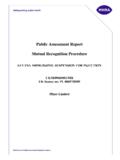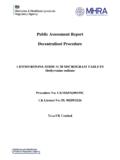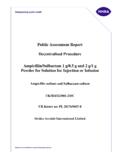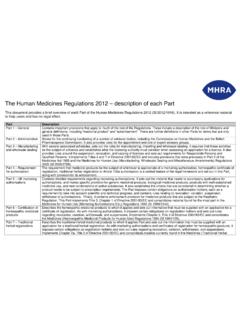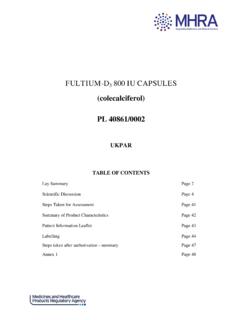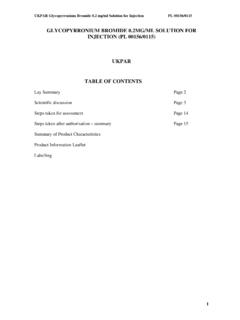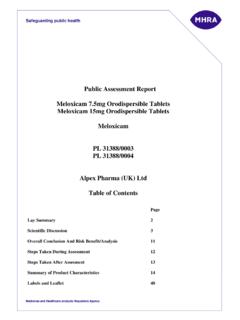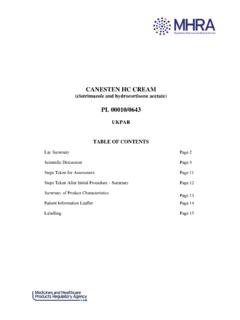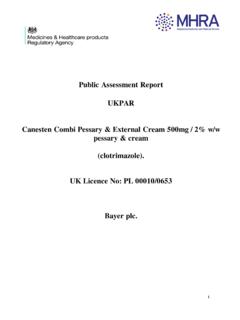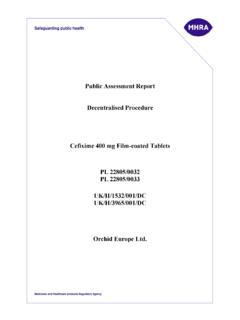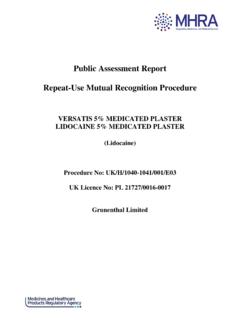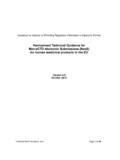Transcription of Public Assessment Report Repeat-Use Mutual Recognition ...
1 PAR SolarazeTM 3% Gel UK/H/0226/001/E022. Public Assessment Report Repeat-Use Mutual Recognition Procedure SolarazeTM 3% Gel UK/H/0226/002/E02. UK licence no: PL 16973/0012. Almirall, 1. PAR SolarazeTM 3% Gel UK/H/0226/001/E022. LAY SUMMARY. This Repeat-Use Mutual Recognition Procedure (UK/H/0226/001/E02) granted a Marketing Authorisation to Almirall SA for the medicinal product Solaraze 3% Gel (PL 16973/0012) in Greece, Spain and Poland; the procedure concluded positively on 18th November 2010. A. national licence for Solaraze 3% Gel was initially granted in the UK on 25th July 1997. Solaraze is a non-steroidal anti-inflammatory gel that is applied to the skin. Solaraze gel is used to treat a skin problem known as actinic or solar keratosis that is caused by long-term sun exposure.
2 Solaraze contains the active ingredient diclofenac sodium, which belongs to a group of medicines known as non-steroidal anti-inflammatory drugs (NSAIDs) and act by reducing fever, and inflammation as well as the ability to reduce pain. No new or unexpected safety concerns arose from this application and it was therefore judged that the benefits of using SolarazeTM 3% Gel outweigh the risks; hence a Marketing Authorisation has been granted. 2. PAR SolarazeTM 3% Gel UK/H/0226/001/E022. TABLE OF CONTENTS. Module 1: Information about initial procedure Page 4. Module 2: Summary of Product Characteristics Page 5. Module 3: Product Information Leaflets Page 9. Module 4: Labelling Page 12.
3 Module 5: Scientific Discussion Page 16. 1 Introduction Page 16. 2 Quality aspects Page 19. 3 Pre-clinical aspects Page 21. 4 Clinical aspects Page 25. Module 6 Steps taken after initial procedure Page 39. 3. PAR SolarazeTM 3% Gel UK/H/0226/001/E022. Module 1. Product Name Solaraze 3%, gel Type of Application Hybrid, Article Active Substance Diclofenac sodium Form Gel Strength 3%w/w Marketing Almirall, Authorisation Holder Ronda General Mitre, 151. 08022 Barcelona Spain. Reference Member UK. State (RMS). Concerned Member Greece, Poland and Spain State (CMS). Procedure Number UK/H/0226/001/E02. End of Procedure 18th November 2010. 4. PAR SolarazeTM 3% Gel UK/H/0226/001/E022.
4 Module 2. SUMMARY OF PRODUCT CHARACTERISTICS. The UK Summary of Product Characteristics (SmPC) for SolarazeTM 3% Gel (PL 12762/0404). is as follows: 1 NAME OF THE MEDICINAL PRODUCT. Solaraze 3%, gel 2 QUALITATIVE AND QUANTITATIVE COMPOSITION. Each gram contains 30mg diclofenac sodium (3% w/w). For a full list of excipients, see section 3 PHARMACEUTICAL FORM. Gel. A clear, transparent, colourless or pale yellow gel. 4 CLINICAL PARTICULARS. Therapeutic indications For the treatment of actinic keratoses Posology and method of administration Use in Adults: Solaraze is applied locally to the skin 2 times daily and smoothed into the skin gently. The amount needed depends on the size of the lesion.
5 Normally grams (the size of a pea) of the gel is used on a 5 cm x 5 cm lesion site. The usual duration of therapy is from 60 to 90 days. Maximum efficacy has been observed with treatment duration towards the upper end of this range. Complete healing of the lesion(s) or optimal therapeutic effect may not be evident for up to 30 days following cessation of therapy. A maximum of 8 grams daily should not be exceeded. Long term efficacy has not been established. Use in the Elderly: The usual adult dose may be used. Use in Children: Dosage recommendations and indications for the use of Solaraze have not been established for use in children. Contraindications Solaraze is contraindicated in patients with a known hypersensitivity to diclofenac, benzyl alcohol, macrogol monomethyl ether 350 and/ or sodium hyaluronate.
6 Because of cross-reactions, the gel should not be used by patients who have experienced hypersensitivity reactions such as symptoms of asthma, allergic rhinitis or urticaria, to acetylsalicylic acid or other non- steroidal anti-inflammatory agents. The use of Solaraze is contraindicated during the last trimester of pregnancy (see Section ). Special warnings and precautions for use The likelihood of systemic side effects occurring following the topical application of Solaraze is very small compared to the frequency of side effects with oral diclofenac, owing to low systemic absorption with Solaraze. This product should be used with caution in patients with a history and/or active gastrointestinal ulceration or bleeding, or reduced heart, liver or renal function, since isolated cases of systemic adverse reactions consisting of renal affection, has been reported with topically administered antiphlogistics.
7 It is known that NSAIDs can interfere with platelet function. Although the likelihood of systemic side effects is very low, caution should be used in patients with intracranial haemorrhage and bleeding diathesis. Direct sunlight, including solarium, should be avoided during treatment. If sensitivity skin reactions occur, discontinue use. 5. PAR SolarazeTM 3% Gel UK/H/0226/001/E022. Solaraze should not be applied to skin wounds, infections or exfoliative dermatitis. It should not be allowed to come into contact with the eyes or mucous membranes. Interaction with other medicinal products and other forms of interaction No drug interactions during treatment with Solaraze have been reported.
8 After topical administration, systemic absorption is limited. Drug interactions applied to orally administered NSAIDs are improbable. Pregnancy and lactation Use in pregnancy: Solaraze is contraindicated during the last trimester of pregnancy (see section ) and should not be used during the first two trimesters of pregnancy unless clearly necessary. If used during pregnancy, Solaraze must not be applied to a large area of the skin (>30% of the body surface) and must not be used for long-term treatment (>3 weeks). There are no adequate data from the use of diclofenac in pregnant women. Animal studies have shown reproductive toxicity(see section ). The potential risk for humans is unknown.
9 The use of prostaglandin synthetase inhibitors in the second and third trimesters of pregnancy may result in: Functional renal injury in the foetus. From the 12th week: oligohydramnios (usually reversible after the end of treatment), or anamnios (particularly with prolonged exposure). After birth: kidney failure may persist (particularly with late or prolonged exposure). Pulmonary and cardiac toxicity in the foetus (pulmonary hypertension with preterm closing of the ductus arteriosus). This risk exists from the beginning of the 6th month and increases if administration is close to full term. Inhibition of uterine contractions. Prolongation of pregnancy and labour. Increased risk of bleeding in the mother and child.
10 Increased risk of oedema formation in the mother. Use during lactation: It is not expected that any measurable amount of diclofenac sodium would occur in breast milk following topical application. Solaraze can be used at the recommended therapeutic dose. However, Solaraze should not be applied to the breast area of nursing mothers. Effects on ability to drive and use machines Not applicable Undesirable effects Most frequently reported reactions include skin reactions such as contact dermatitis, erythema and rash or application site reactions such as inflammation, irritation, pain and blistering. In studies there appeared to be no age specific increase or pattern of reactions.
